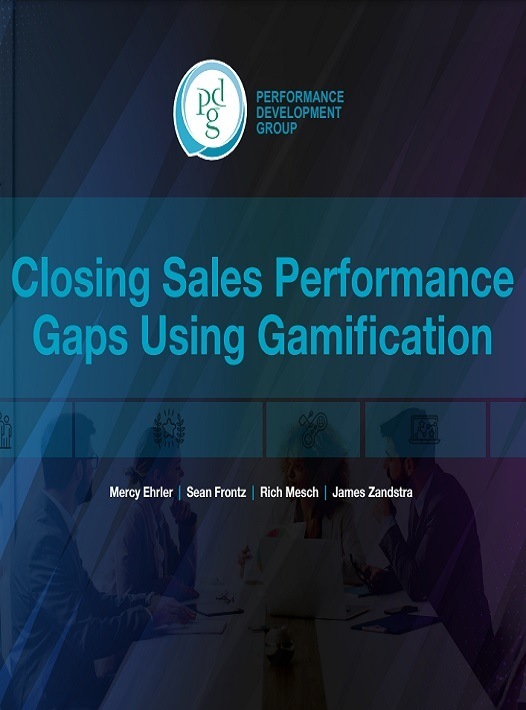A Working Definition
According to the Oxford Online Dictionary: “Gamification is the application of typical elements of game playing (e.g., point scoring, competition with others, and rules of play) to other areas of activity…[in order] to encourage engagement.”
Put simply, gamification uses gaming principles in a non-game context. For instance, participants can engage in activities to gather points and earn badges. Gamification taps into our inherent competitive spirit and desire to win. The result is an increase in attentiveness and engagement, resulting in a higher level of learning and behavior change.

eBook Release
Closing Sales Performance Gaps Using Gamification
What if you turn your learning tracks and coaching into something that is fun, exciting, and entertaining and that actually closes sales performance gaps? Enter gamification.
Gamification In Real Life
If you’re a Starbucks drinker and collect “stars” toward a free meal or drink, you’re participating in a game designed to get you to consume more Starbucks. These reward programs work and are pervasive within the retail industry.
Duolingo is another popular example of gamification in action. Every time you take five minutes out of your day to complete your Spanish lesson, you are engaging in gamification, where you work to win points, climb your weekly leaderboard, and earn rewards in the form of in-app currency.
The millions of smartwatch wearers worldwide will be very familiar with gamification in action. The activity tracker reminds you to keep moving to hit your daily step count, and it tells you when your friends have completed a run or a cycle, motivating you to keep up with your peers and maintain your own activity goals.
Why Does Gamification Work?
Gamification is a powerful tool because of how the human brain works. It stimulates the brain, causing the release of dopamine (the hormone that generates good feelings when we complete specific actions) and endorphins (a natural chemical that reduces stress and anxiety). Achieving goals, receiving badges or points, and moving up a leaderboard triggers the release of these chemicals, compelling participants to return to engage with the content.
Gamification is effective because it creates a story around a topic. And stories help create an emotional connection with the content. When you present content as a story, it’s easier to recall. Think about the countless fables and parables that you know. It’s much easier to visualize and internalize the story of the tortoise and the hare than an abstract concept from a textbook. Gamification goes one step further by inviting the player to actively participate in the story, making it an even more memorable, immersive learning experience.
There are dozens of statistics to back this up in the professional world. Here are just a few. Companies with effective gamification have experienced:
- 50% improvement in employee productivity
- 60% increase in employee engagement
- 83% of employees with higher motivation
- 14% higher scores in skill-based assessments
Busting The Myths Around Gamification
Gamification doesn’t always have the best reputation—though this isn’t necessarily fair. Some of the common myths, and the reality, include:
- Gamification is a distraction
If you reach your organizational goals, does it really matter how you get there? A formal training workshop may be more recognizable as a way to develop skills, but if gamification imparts the right skills and knowledge to the right audience, it’s a powerful tool—not just a distraction. - Gamification isn’t for adults
There are more than 3.24 billion gamers (that is, people who play any video games) worldwide, a significant proportion of which are adults. Gamification is a fantastic tool for engaging adults and tapping into their intrinsic motivational drivers. - “Gamification” is just a fancy word for games
Not true! Just look at the examples above. Do you feel like you’re playing a game when you’re collecting stars for your morning macchiato? Or when your smartwatch vibrates to remind you to go for a walk? - Gamification is just a fad
Duolingo was founded in 2011 and now has over 500 million users worldwide. When it’s done right, gamification is one of the most powerful tools in your arsenal for engaging your audience and keeping them inspired. - Gamification is a quick fix for low engagement
When it comes to changing behaviors and significantly transforming the skills and capabilities of a team, there is no quick fix. However, gamification can take place in short, sharp bursts—just five minutes a day can be enough to embed new habits and behaviors into someone’s daily activities.
Conclusion
Download the eBook Closing Sales Performance Gaps Using Gamification to identify and address pain points that prevent your sales teams from achieving their goals. You can also join the webinar to learn how to close gaps for good and help sales reps who struggle to meet their quotas.

